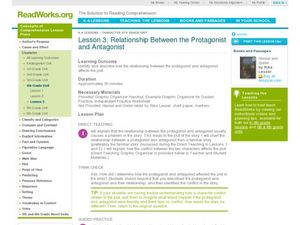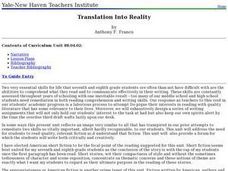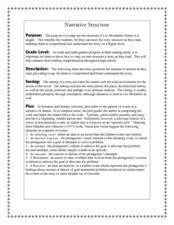Curated OER
Creating Interesting Characters
What makes a story interesting? Complex characters! As part of a series of worksheets that prepares middle schoolers to write their own novel, the exercises included explain the role of the protagonist, the antagonist, and the supporting...
Read Works
Protagonist
Teach your class how to identify the protagonist in a story. The plan suggests starting with a protagonist from a tale you have previously read in class. Then, you can read a new story and work together to identify the protagonist,...
Curated OER
Comprehension-Characters/characterization
Fifth graders discuss characterization as well as to define antagonist and protagonist. In this language arts lesson, 5th graders write questions for an interview of a character in the book "The Three Little Pigs" and then answer them....
Curated OER
Points of View
Cinderella is a classic love story when Cinderella is the protagonist—but what happens if a stepsister tells the story? Focus on point of view with a lesson about fairy tales and story elements. After reading a few familiar fairy tales,...
Curated OER
Relationship Between the Protagonist and Antagonist
Students read Hansel and Gretel, and discuss the conflict in the story, while determining who the protagonist and the antagonist are. In this fiction lesson, students chart the conflict in the story they have just read.
K20 LEARN
The Most Dangerous Game
Readers of "The Most Dangerous Game" must argue which of Richard Connell's characters is the protagonist or antagonist. The lesson begins with scholars reading selected passages from the story and making predictions about who they...
Curated OER
Character in a Bag
Develop a mystery character using clues from a bag. This engaging activity will help learners understand character traits. They develop a list of the items from the bag, discuss and develop the character with a partner, and create a...
Curated OER
Primary Sources and Protagonists: A Native American Literature Unit
Introduce your middle schoolers to the lives of past Native Americans. First, learners work together to put photographs in a sequence. Then, using their sequence, they create stories to share with the whole class. No matter how old your...
Curated OER
Antagonist
Young learners explore the antagonist. They retell Hansel and Gretel and identify the witch and the stepmother as antagonists. They then brainstorm common character traits of an antagonist, and then write a paragraph describing an...
Curated OER
Make Up Your Story
Putting together an interesting story can be hard, but this set of worksheets will guide your writers into the depths of their own creativity as they characterize both their main character and villain. Using humor to keep learners...
Curated OER
Translation Into Reality
Students read a variety of short stories that focus on teenage protagonists. In groups, they answer comprehension questions and discuss the characters and setting for each story. Individually, they choose one writing assignment to...
Teach With Movies
Learning Guide to: Schindler's List
Take your history class through Schindler's List with a learning guide, which offers an introduction to the film and a variety of discussion questions and related assignments. There are several useful resources in the sidebar, such as a...
Curated OER
Details, Details, Details
Writing can become one-dimensional if authors don't involve all their senses. First, scholars observe a strange object which, ideally, they can touch and even smell. Without using certain words (you can create a list or have the class...
Arts Midwest
The Joy Luck Club: Culture and History
Explore San Francisco's Chinatown in a lesson about the first few chapters of The Joy Luck Club by Amy Tan. Kids research Chinatown on the Internet and create a virtual tour of the neighborhood, including the foods, cultural events, and...
Curated OER
Hubris Lesson Plan
Bring this lesson on hubris to your short story unit. After reading Jack London's "To Build a Fire," young readers discuss the role of hubris in the protagonist's death. The lesson has connections to other short stories, such as "The...
Curated OER
Character Bust: Ceramics Lesson
Whether it is a protagonist, antagonist, hero or heroine, characters are a must in any story. Learners analyze a character from a narrative they are reading, then use that character as inspiration. They create a ceramic bust depicting...
Curated OER
The Nature of the Antagonist
Students explain the differences between protagonists and antagonists and recognize the fundamental purpose of an antagonist or villain in storytelling. They also explain conflict as used in literature.
Curated OER
Fallen Angels
Students read the novel, Fallen Angels, and examine the theme of coming of age during the Vietnam War. They create timelines of the 1960s, highlighting important issues of the era. They write research papers focusing on one particular...
Curated OER
Evaluating a Book By Its Cover
Learners practice using predictive strategies before reading a book. In this literacy lesson, students identify the theme and characters of the novel based on the cover illustrations.
Curated OER
Responding to Literature: James and the Giant Peach
Fifth grade reader/writers create an alternate ending to an episode in Roald Dahl's James and the Giant Peach in which our protagonist "loses" the chance to magically solve all his problems. Prompts students not only to write creatively...
Curated OER
"The Tell-Tale Heart"- It's a Matter of Point of View
How does the point of view of Poe's protagonist in "The Tell-Tale Heart" contribute to the suspenseful tone? Help your middle schoolers identify the point of view in a literary work with this instructional activity, which goes on to...
EngageNY
Analyzing Word Choice: Understanding Working Conditions in the Mills
Ravenous or hungry, happy or ecstatic—why does word choice matter? Scholars continue to analyze working conditions in the mill and how the conditions affect the protagonist of Katherine Paterson's novel, Lyddie. They engage in a close...
Curated OER
Narrative Structure: Les Miserables
What is the initiating event? What is the protagonist's goal? What attempts are made to achieve this goal? What is the outcome? Model for your class how to map out the structure of any narrative. Readers then search for answers as the...
Curated OER
Character Sketches
Young scholars are introduced to the types of characters found in short stories. They read a short story in class and produce sketches of the protagonist and antagonist. Finally, they create their own characters and write about them in...
Other popular searches
- Antagonist vs. Protagonist
- Comic Protagonist
- Protagonist and Antagonist
- Antagonist vs Protagonist
- Antagonist Protagonist
- Antagonists and Protagonist
- Protagonists and Antagonists
- Dystopian Protagonist
- Dustpan Protagonist
- Protagonists vs Antagonists
- Antagonists Protagonists
- Protagonist + Antagonist

























